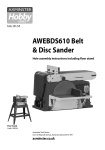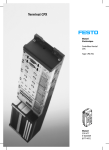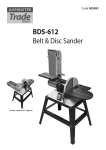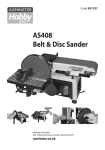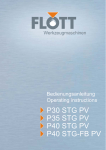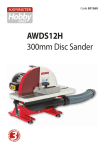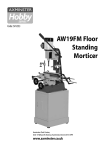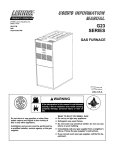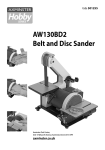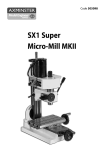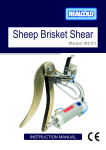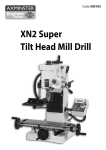Download Axminster AWEBDS46 MkII Instruction manual
Transcript
Code: 501256 AWEBDS46 MkII Belt and Disc Sander Axminster Tool Centre, Unit 10 Weycroft Avenue, Axminster, Devon EX13 5PH axminster.co.uk Index of Contents Page No. 02 03 04 05 06-07 07-08-09-10-11-12 12-13 14 14-16-18 15-17-19-20 21 22 23 23-24 25-26-27 Index of Contents Declaration of Conformity What’s in the Box General Instructions for 230V Machines Specific to Sanding Machines Assembly Fitting the Fence Assembly Specification Identification and Description of the Sander Illustration and Parts Description Vertical Sanding Changing the Sanding Belt Changing the Sanding Disc Maintenance Parts Breakdown/LIst symbols below advise that you follow the correct Warning The safety procedures when using this machine. Fully read manual and safety instructions before use 02 Ear protection should be worn Eye protection should be worn Dust mask should be worn HAZARD Motor gets hot Declaration of Conformity Copied from CE Certificate The undersigned, F. Nispel authorised by Weihai Y&X Electrical Machinery Co., Ltd. Sunjia Tuan Town Weihai, Shandong 264201 P.R.China declares that this product: Belt and Disc Sander MM491E manufactured by Weihai Y&X Electrical Machinery Co. is in compliance with the following standards or standardisation documents inaccordance with Council Directives EN 55014-1: 2000+A1+A2 EN 61000-3-2: 2000 EN 61000-3-3: 1995+A1 EN 55014-2: 1997+A1 03 What’s in the Box Model Number: MM491E Box: 1 No. Belt & Disc Sander (Sanding Belt Fitted) 1 No. Work Stop Plate 1 No. Sanding Disc Cover Plate 1 No. 150mm Sanding Disc 1 No. Mitre Fence 1 No. Disc Table 1 No. Instruction Manual 1 No. Disc Table Support Bracket Bag 1 Containing: 2 No. M4 Phillip Head Screws 4 No. M6 Bolts 4 No. Shake Proof Washers. 5 No. M6 Washer 1 No. Adhesive Scale Label 1 No. Star Knob Threaded Bolt Bag 2 Containing: Adjustable Fence Assembly Part 1 1 No. Mounting Guide Assembly, two rods shouldered and threaded 1 No. Tower Bracket Casting, with two butterfly thumb screws. at each end, with a metal strap and 4 nuts and 2 washers. Bag 3 Containing: Adjustable Fence Assembly Part 2 1 No. Concave Bracket Casting 1 No. Fence with Base Plate Casting Having opened the box, remove all the components stowed in the packaging. Place these carefully to one side. Remove the top packaging and lift the machine out of the box and place upon a clear flat surface, taking care not to trap or pinch the power cable under the chassis. Remove any other items from the box. Having unpacked your sander and its various components, if you do not wish to retain the packaging please dispose of it responsibly, especially any polystyrene; most of the rest of the packaging is biodegradable. Please read though the Section entitled Identification and Description of parts of the Sander, as this will ensure that you better understand the terminology we will use during the assembly and setting up phases. NOTE: Please read the Instruction Manual prior to using your new machine; as well as the operating procedures for your new machine, there are numerous hints and tips to help you to use the machine safely and to maintain its efficiency and prolong its life. Keep this Instruction Manual readily accessible for any others who may also be required to use the machine. 04 General Instructions for 230V Machines Good Working Practices/Safety The following suggestions will enable you to observe good working practices, keep yourself and fellow workers safe and maintain your tools and equipment in good working order. ! WARNING!! KEEP TOOLS AND EQUIPMENT OUT OF THE REACH OF YOUNG CHILDREN Mains Powered Tools (General) /Disc & Belt Sander Primary Precautions These machines are supplied with a moulded 13 Amp. Plug and 3 core power cable. Before using the tool inspect the cable and the plug to make sure that neither are damaged. If any damage is visible have the tool inspected/repaired by a suitably qualified person. If it is necessary to replace the plug, it is preferable to use an ‘unbreakable’ type that will resist damage on site. Only use a 13 Amp plug, make sure the cable clamp is tightened securely. Fuse at 5 Amp. It is also good practice to use switched outlets. If extension leads are to be used, carryout the same safety checks on them, and ensure that they are correctly rated to safely supplythe current that is required for your machine. This machine is intended primarily for workshop usage. Work Place/Environment Always mount the machine on a flat, level stable surface. There are several methods of achieving this, bolting the machine directly to a ‘good solid workbench’, bolting the machine to a sturdy base board that can be clamped to the ‘good solid workbench’; create an independent entity by bolting the machine to its own stand. However you mount your machine, make sure it is fastened down and stable before use. Paper belts and discs do not respond well to wet or damp conditions. In the worst case the adhesives holding the belt and the abrasive fail completely, the belts fall apart and the abrasive becomes a soggy mess against the edge of your work piece. Try to keep the machine in a reasonably dry, warm environment. If this is not possible; or if the machine is to remain unused for some time, at least remove the belt, put in a ‘plastic’ bag (your partner will take a dim view of sawdust trails) and store in a warm dry place. I’m afraid I can offer no suggestions for the disc, unless you have upgraded to some form of ‘velco’. fastening method, in which case, do the same as with the belt. (Don’t leave the spare belts/discs in the damp). Keep the work area as uncluttered as is practical, this includes personnel as well as material. ! WARNING!! UNDER NO CIRCUMSTANCES SHOULD CHILDREN BE ALLOWED IN WORK AREAS 05 Specific to Sanding Machines ! WARNING! THE SANDING DISC CANNOT BE DECLUTCHED FROM THE BELT AND VICE VERSA, BOTH FUNCTIONS ARE ACTIVE WHEN THE MACHINE IS RUNNING. REMEMBER THIS, AND DO NOT LEAVE LOOSE OBJECTS OF ANY DESCRIPTION, ON THE MACHINE IF IT IS GOING TO BE USED. Once the sander is mounted, carry out any setting operations, (mitre, tilt..?), and remove all tools used in the setting operations (if any) and place safely out of the way. If you are working long lengths of material arrange for extra support beyond the boundary of the machine, and check you have sufficient room to manoeuvre the material through all the operations you will wish to carry out. It is good practice to leave the machine unplugged until work is about to commence, also make sure to unplug the machine when it is not in use. Always disconnect by pulling on the plug body and not the cable. After fitting a new sanding disc, it is good practice to lightly sand across the left side of the disc with a reasonable sized (20mm x 50mm) piece of timber to make sure the sanding disc is correctly ‘seated’ on the disc. The sanding action will press the sanding disc firmly back against the disc itself. It is not good practice to wear gloves whilst sanding as one tends to lose the ‘feel’ of the workpiece/sander contact, but obviously this removes the safety barrier between your fingers and the sanding surface. Remain focused and exercise caution whilst sanding. DO NOT sand very small pieces of work with bare hands; try to construct some form of holder. MAKE SURE you are comfortable before you start work, balanced, not reaching etc. If the work you are carrying out is liable to generate excessive grit or dust or chips, wear the appropriate safety clothing, goggles, masks etc., If the work operation appears to be excessively noisy, wear ear-defenders. If you wear your hair in a long style, wearing a cap, safety helmet, hairnet, even a sweatband, will minimise the possibility of your hair being caught up in the rotating parts of the machine, likewise, consideration should be given to the removal of rings and wristwatches, if these are liable to be a ‘snag’ hazard. DO NOT work with cutting/abrasive tools of any description if you are tired, your attention is wandering or you are being subjected to distraction. A deep graze, a lost fingertip or worse, is not worth it! DO NOT use the machine within the designated safety areas of flammable liquid stores or in areas where there may be volatile gases. There are very expensive, very specialised machines for working in these areas, THIS IS NOT ONE OF THEM. CHECK that sanding surfaces are still sufficiently abrasive to carry out the work you intend. Sanding belt cleaning sticks are an efficient method of prolonging the life of the belts and discs, and will also maintain their operating performance. 06 Specific to Sanding Machines CHECK that the belts or discs are undamaged; torn edges can pick up on the workpiece and will cause the medium to tear, often very rapidly with accompanying sharp flapping edges. ALWAYS offer the workpiece to the belt/disc so that the motion carries the work against the restraining surface, (i.e. the work stop or the table, (use the left hand side of the disc). DO NOT press too heavily against the sanding surface, all this will do is slow the sander down. Remember, sanders work by removing small particles of material quickly and heavy pressure works adversely to the cutting process, further, it will accelerate the rate of ‘clogging’ of the abrasive surfaces, rendering the machine less efficient. If you are attempting to sand inside curves (over the ‘tracking drum’) do not press at all, other than to keep the workpiece in contact with the surface, any pressure could upset the tracking geometry. As there is no cushioning effect to the belt passing around the drum, expect an added vibration and compensate for it. Sanding of certain types of timber may make the fitting of dust extraction mandatory in order to comply with the directives of the HSE. However, even if it is not mandatory, it is strongly recommended that you consider fitting dust extraction. It will certainly reduce the level of dust and grit, and as it helps to remove the waste quicker will certainly prolong the longevity of the abrasive. Above all, OBSERVE…. make sure you know what is happening around you, and USE YOUR COMMON SENSE. Assembly In order to reduce the footprint of the machine for packaging, several items are dismounted from the machine and need to be re-affixed. Locate the disc support casting and disc table. Turn the table over, place the bracket onto the table as illustrated. (See fig 1) Locate the three shake proof washers and M6 washers, place them over the threaded holes (See fig 2), insert the three M6 bolts and (finger tighten). Tighten the bolts using a 10mm spanner. (See fig 3) DO NOT over tighten, remember this is a casting. Disc table support casting Fig 1 Disc Table 07 Assembly Fig 2 M6 washer Shake proof washers WARNING!! DO NOT over tighten remember this is a casting Fig 3 Spanner Put the table assembly aside to fit later see page 9. Fitting the Sanding Disc Clean the surface of the disc with a degreasing cleaner, (methylated spirit; acetone nail polish remover borrowed from the female side of the family, if you don’t have a proprietary cleaner.) Allow to dry off and wipe over with a clean dry cloth. Locate the sanding disc, peel the cover from the adhesive surface and apply CAREFULLY to the disc. (See fig 4) Use a piece of cloth in your hand or wear a glove, to firmly press the abrasive to the disc, the application will be reinforced by a gentle sanding action across the face when you first use the new sanding disc. Sanding disc 08 Fig 4 Assembly Locate the sanding disc cover plate & the two M4 phillip screws and secure in place as illustrated. (See fig 5) Sanding disc cover plate Fig 5 Locate the table scale label, peel back the cover from the adhesive surface and apply CAREFULLY to the extraction port moulding. (See fig 6) Extraction port moulding Table scale label Fig 6 Offer up the table and introduce the star knob threaded bolt through the slot in the clamping quadrant and screw into the chassis. (See fig 7) Leave sufficient gap between the table edge and the disc by loosening the table fixing bolts and slewing the table until the disc spins freely. Proceed to tightened up all screws and bolts, Do not over tighten the bolts, remember the table is a casting. Set the table to 90° according to scale on the extraction port moulding. Fig 7 09 Assembly Use a known 90° reference (square?) and check that the table is set square to the sanding disc. If it is not, reset the table until it is correct (See fig 8). Square Extraction port moulding Scale Fig 8 Fig 9b Slide the mitre fence into the tables ‘T’ slot. (See fig 9) Place a 90˚square up against the mitre fence to make sure it’s perpendicular to the sanding disc. (See fig 9a) If not, adjust the angle of the mitre fence until correct, and then reset the index marker to read 0˚ degrees. (See fig 18) Fig 9 Square Mitre fence Fig 9a 10 Index marker Assembly Fence Assembly C A Remove the Butterfly nut and M6 washer A D Base plate B B Fence Tower bracket C Lower the concave bracket over the fixing bolt onto the base plate. M6 washer Index pointer Lower the tower bracket over the bolt, fit the M6 washer. D Typ. 2 Thumb screws Replace the M6 butterfly nut and finger tighten. mounting guide assembly Loosen the two thumb screws on either side of the tower bracket and slide the mounting guide assembly down until it is against the tower bracket. Put aside to fit later see pages 12 & 13 11 Assembly Fitting the workstop plate Locate the work stop plate for the linisher, and fit to the chassis using the M6 bolt, shake proof washer and M6 washer. (See fig 16). Fig 10 Fitting the Fence Assembly ! DISCONNECT THE MACHINE FROM THE MAINS SUPPLY Note: You will require a 14mm A/F spanner To fit the fence assembly requires that you remove the linishing belt to gain access. PLEASE NOTE: the workstop plate has been removed for clarity Before starting you will need to tilt the linisher assembly into the vertical position, to do this slacken off the swivel mandrel clench bolt which is located near the drive belt cover, raise the linisher and then re-tighten the bolt to prevent it from coming down. (See figs 11 & 12) Swivel mandrel clench bolt Fig 11 12 Fig 12 Fitting the Fence Assembly Fig 14 Fig 13 Remove the extraction port moulding by undoing the two Phillip screws (See fig 13) Release the belt tension by pressing the belt tension lever towards the drive drum end. (See fig 14) Belt tension lever Extraction port moulding Fig 15 Slide the belt off (See fig 15); you can now access the inside of the linisher casing. Fence assembly Fig 16 Belt Locate the fence assembly, remove the two nuts and washers from the mounting rods, line up the mounting rods with the holes in the linisher casing; insert them and fasten in place with the nuts and washers you removed earlier. (See fig 16) Mounting rods Replace the belt by sliding it back over the drum then push the tension lever back up towards the tracking drum. Replace the extraction port moulding, taking care to observe the correct alignment between the table index marker & the scale. 13 Specification Model Product Code Rating Power Belt Speed Belt Size Diameter of Disc Table Size Belt Table Size Disc Dust Extraction Outlet Overall L x W x H Weight AWEBDS46 MkII 501256 Hobby 375W 517m/min 100 x 915mm 150mm 200mm x 110mm 225mm x 155mm 63mm 536 x 460 x 370mm 20kg Identification and Description of the Sander Chassis (See fig 17) This is the main body of the machine, all the other components are mounted onto the chassis. Linisher body (See fig 17) This is the long flat box that carries the linishing belt, it is mounted on the chassis via a swivel joint about the drive axle mandrel. It mounts the tensioning/tracking drum, and the various mechanisms for tensioning and tracking the belt. Linishing belt (See fig 17) This is the flat belt that is driven along the linishing platen to provide the long, wide flat abrasive surface upon which the majority of sanding is carried out. Belts of different abrasive types and loadings are available. Work Stop plate This is a flat metal plate fastened to the linisher chassis. Its purpose is (See fig 19) to provide a stop against which the work can be held during sanding. Disc (See fig 17) A 6 inch alloy disc, mounted on the end of the drive drum axle. It can mount a wide range of abrasive types and grits. On/Off switches There is an On/Off switch mounted on the machine that controls the (See fig 18a) main contactor, which fulfills the NVR function of the machine. 14 Drive belt cover (See fig 19) The cover that guards the drive belt. It must be removed to check the condition of, or to change, the drive belt. Drive drum (See fig 23) This is the drum that provides the belt movement, it is driven by a pulley and drive belt by the motor and is fixed to the chassis and is referenced to the platen, it is the reference against which the ‘tracking drum’ works in order to maintain the tension and the linear motion of the belt. The drive drum axle fits through a mandrel, around which the swivel joint of the linisher can be rotated. Illustration and Parts Description Guide fence assembly Linishing belt Fig 17 Linisher body Disc Chassis Mitre fence Locating slot On/Off switches Index marker Disc table Off Fig 18a On Fig 18 15 Identification and Description of the Sander 16 Belt tensioning lever (See fig 19) The belt-tensioning device is a cranked lever; pivoted about halfway along its length on a pin set in the underside of the linisher chassis. A spring is connected to the end of the cranked part of the lever, which pulls it towards the end of the chassis. The idler drum is mounted in a yoke. The stem of the yoke is slotted; this slot also fits over the pivot pin. The yoke is also fastened to the lever, such that the movement of the lever pulls the yoke down the slot releasing the tension of the idler drum against the belt. The cranking of the lever is to enable an ‘overcentre hold’ of the lever when it is moved to the ‘untension’ position against the action of the spring. When the lever is pushed in the opposite direction, it moves the yoke back up the slot so that the idler drum is held against the belt under the pressure of the spring. Tracking adjuster (See fig 19) The belt is tracked by pivoting the yoke with the idler drum about the pin in the chassis. The control of this movement is effected by a Star knobbed bolt fitted through a hole in the linisher chassis and introduced into a threaded hole in the side of the yoke. The yoke is held in position using a spring acting between the chassis and the yoke, with its actual position governed by the adjusted length of the threaded bolt. Swivel mandrel casting (See fig 19) This is the casting that mounts the linisher to the main machine chassis, the casting forms a swivel joint over the drive shaft mandrel. The casting is split and is clenched onto the mandrel using a bolt through the two cast lugs. Slackening the bolt allows the linisher to be tilted up to the vertical position. Dust extraction port (See fig 19) The dust extraction port is moulded into the chassis cover, directly below the dust deflector over the drive drum. The lower section of the chassis is accessed by the extraction port, so the resulting draught will remove the dust from the disc sander, and also encourage airflow past the motor. Linisher platen (See fig 23) This is the flat surface of the machine that supports the belt and maintains it in plane during sanding operations. Motor (See fig 27) The motor is housed in the chassis body. A pulley and drive belt connect the motor shaft output to the pulley on the drive drum. Air vents (See fig 24) Preformed ventilation slots in the lower cover plate to allow air to be ducted to the motor for cooling and into the dust extraction system. Ensure that the air vents are not covered during operation and that they do not become clogged. Disc table (See fig 17) A good-sized table mounted on a support casting. The Table has a ‘T’ slot machined into it, parallel to the front edge to allow the mounting of the mitre fence attachment. The underside of the front edge of the table is bevelled so that the table can be tilted down without fouling the sanding disc. Illustration and Parts Description Fence Tracking adjuster Work stop plate Belt tensioning lever Fig 19 Star knob threaded bolt Drive belt cover Swivel mandrel Dust extraction port Star knob threaded bolt Scale Fig 20 Index marker 17 Identification and Description of the Sander Disc table support casting (See fig 1) The support casting is the main support for the disc table. It has the pivot spigot and a slotted quadrant which allows the table to be set to a known angle. The casting has a moulded pointer to read against the scale. The support casting is clamped into position by a star knob threaded bolt, which clamps the quadrant to the chassis. Mitre fence The mitre fence assembly is mounted on a ‘T’ bar which engages in the (See figs 17 & 18) slot machined in the table. It is capable of being turned through ± 60°. Guide fence comprises: - two rods that are shouldered and threaded at each end, assembly a metal strap, a ‘tower bracket casting’, the two castings that form the (See figs 21 & 22) pivot joint and the fence itself. The two mounting/guide rods are secured through the metal strap that holds them at a fixed pitch. The base of the ‘tower bracket’ has a tube housing on either side which fit over the rods and allows it to slide back and forth. Small thumb screws in the housings can be tightened through against the rods allowing the bracket to be ‘locked’ in position. There is a vertical slot in the tower bracket. The concave bracket casting of the pivoting joint mounts against the tower. On one side of the concave bracket is a ‘lazy ‘Z’ extrusion cast in such a way as to allow it to form the stops for the fence preset angle device. On the other side a small pointer has been cast to act as the index maker for the angle scale. The concave casting is ‘slotted’ to allow the fixing bolt to pass through it. The flat base plate of the convex part of the pivoting joint is bolted onto the back of the fence by square head bolts and nuts. The bolt heads are captured in ‘T’ slots in the extrusion that is used for the fence. Loosening the nuts will allow the fence to be slid ‘along the bolts’ to reposition it. One side of the base plate has a quadrant casting with a raised scale on it which can be read against the index pointer on the concave part; the other side has two threaded holes. The holes have small bolts with lock nuts, and are positioned to correspond with the geometry of the lazy ‘Z’ on the concave part, and are the other part of the ‘angle presetting’ device. The convex casting is slotted to allow the fixing bolt to pass through it. The gauge of the slot is such that it will capture the square of the carriage bolt, allowing the butterfly nut to be tightened. The two parts of the pivot joint are fitted together, positioned and then secured with the carriage bolt, which feeds through the two parts of the joint, the slot in the tower bracket and is fastened with a washer and butterfly nut. Sanding disc cover plate (See fig 5) 18 This protective steel plate is fixed to the pastic moulding at the base of the sanding disc by two Phillip screws. Illustration and Parts Description Concave casting Quadrant casting Lazy ‘Z’ ‘T’ slot Fig 21 Fence Butterfly nut Vertical slot Belt tensioning lever Metal strap Tower bracket Thumb screw Rod Scale Fig 22 Pointer 19 Illustration and Parts Description Fig 23 Idler drum Star knobbed bolt Linisher body Yoke Cranked lever Spring Drive drum Linisher platen Fig 24 Air vents 20 Vertical Sanding Raising the linisher to vertical If you require to raise the linishing table to the vertical using the 6mm Allen Key provided loosen the swivel mandrel caphead bolt (See fig 11). Raise the linisher table either to its vertical stops or to the position required & re-tighten the swivel mandrel-clamping bolt. Once the linisher is in the vertical position the work stop plate can be used to support small pieces while sanding. Mounting the disc table to the Linisher The sanding disc table can be mounted in place of the workstop plate to give more support and the use of the mitre fence. Remove the work stop plate from the linisher chassis and place safely aside. Undo the star threaded bolt and remove the table. Line up the table to the embossed hole in the linisher chassis then introduce the star knob threaded bolt through the slot in the clamping quadrant and screw into the threaded hole in the linisher chassis. (See fig 25) Use a known 90° reference (square?) and check that the table is set square to the belt sander. Introduce the table spigot into the hole in the linisher chassis. Fig 25 introduce the star knob threaded bolt through the slot in the clamping quadrant and screw into the threaded hole in the linisher chassis. The disc table mounted to the linisher 21 Changing the Sanding Belt ! DISCONNECT THE MACHINE FROM THE MAINS SUPPLY Slacken off the swivel mandrel-clamping bolt (See fig 11) then refer to “Fitting the Fence Assembly” to remove the necessary guards and covers. Release the belt tension by pressing the lever towards the drive drum (See fig 15) and slide the belt off the machine. (See fig 16) Inspect the new belt, ensure that there are no tears or rips (especially along the edges), check the direction arrows on the inner surface of the belt and fit accordingly. (The direction of the arrows should point to the drive drum end of the machine). Note: If you are using an old belt, and the arrow marking has worn off, check the direction of travel (see diagram below.) Direction of travel Belt overlay Belt underlay Glue joint Tracking the belt NOTE1: All directions are given from the view point of the operator standing behind the drive drum end looking down the length of the machine. The tracking control works as follows:- turning the tracking adjuster clockwise will track the belt to the right, anti-clockwise will track the belt to the left. DO NOT make large adjustments, and remember the belt may take some time to react to your alteration. Little by little is a good maxim to observe when carrying out tracking operations. NOTE2: NOW here you can wear a glove. Using your hand, roll the belt towards the drive drum end, check that the belt stays in the middle of the table, if not adjust the track control slightly, and move the belt again, continue until the belt runs down the centre of the linishing table. When you are comfortable that the belt is tracking in one line, reconnect the mains supply, and switch the machine ON. Be prepared to adjust the original track setting as the belt being driven can generate slightly different dynamics to the belt being ‘hand turned’. 22 Changing the Sanding Disc ! DISCONNECT THE MACHINE FROM THE MAINS SUPPLY Lift the edge of the disc and, gripping firmly, peel the disc away from the plate; turning the plate as required to free the entire disc. Remove and throw away. If you have been extremely fortunate all the adhesive will have been removed with the disc. As this is rarely the case, be prepared to rub, scrape, pick etc., to remove all the odd patches of adhesive and render the plate CLEAN. Fit the new sanding disc as detailed in the instruction “Assembly”. Maintenance ! DISCONNECT THE MACHINE FROM THE MAINS SUPPLY Ventilation plate There is very little mechanical maintenance that can be carried out on the machine. Most prudent maintenance is preventative and concerned with keeping the machine clean. Remove the belt and check there is no dust or resin build up on the drums or at the edges of the platen. At reasonable intervals, turn the sander on it side and remove the ventilation plate by undoing the three securing screws, (See figs 26 & 27) inspect and remove all dust/resin build ups, and blow the motor clean. Fig 26 Securing screws Remove the lower sanding disc guard, the dust deflector and the extraction port moulding, remove any build up’s and clean them thoroughly to allow the dust to travel over their surfaces smoothly. Remove the drive belt cover and check that the belt is not frayed, worn or loose. (See figs 28,29) Replace all guards and covers, etc., Reconnect to the supply and start up the machine, check that nothing has disturbed the tracking. Fig 27 Motor 23 Maintenance Fig 28 Drive belt Fig 29 24 Parts Breakdown/List 25 Parts Breakdown/List 26 Parts Breakdown/List 27 Please dispose of packaging for the product in a responsible manner. It is suitable for recycling. Help to protect the environment, take the packaging to the local recycling centre and place into the appropriate recycling bin. Only for EU countries Do not dispose of electric tools together with household waste material. In observance of European Directive 2002/96/EC on waste electrical and electronic equipment and its implementation in accordance with national law, electric tools that have reached the end of their life must be collected separately and returned to an environmentally compatible recycling facility.




























